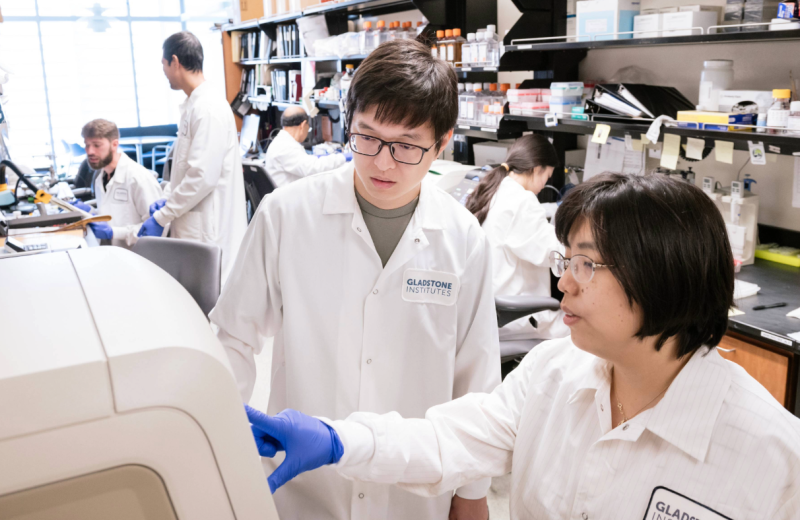Gladstone NOW: The Campaign Join Us on the Journey✕

Drs. Lennart Mucke and Dena Dubal revealed that increasing levels of klotho in Alzheimer mice improved their cognitive function in spite of disease-causing proteins in the brain. [Photo: Chris Goodfellow, Gladstone Institutes]
Scientists from the Gladstone Institutes and the University of California, San Francisco report in the Journal of Neuroscience that raising levels of the life-extending protein klotho can protect against learning and memory deficits in a mouse model of Alzheimer’s disease. Remarkably, this boost in cognition occurred despite the accumulation of Alzheimer-related toxins in the brain, such as amyloid-beta and tau.
Klotho decreases naturally with aging, which also leads to a decline in cognitive ability. An earlier study from these researchers revealed that having a genetic variant that increases klotho levels is associated with better cognition in normal, healthy individuals, and experimentally elevating klotho in mice enhances learning and memory. However, klotho’s influence in the face of aging-related cognitive disorders like Alzheimer’s disease was unclear.
To test klotho’s protective capacity, the scientists created a mouse model of Alzheimer’s disease that produced higher levels of this protein throughout the body. Ordinarily, Alzheimer’s-model mice have cognitive deficits, abnormal brain activity, and premature death, but raising klotho levels ameliorated these problems. The cognition-enhancing effects of the protein were powerful enough to counteract the effects of Alzheimer-related toxins, whose levels were unchanged.
“It’s remarkable that we can improve cognition in a diseased brain despite the fact that it’s riddled with toxins,” says lead author Dena Dubal, MD, PhD, an assistant professor of neurology and the David A. Coulter Endowed Chair in Aging and Neurodegenerative Disease at UCSF. “In addition to making healthy mice smarter, we can make the brain resistant to Alzheimer-related toxicity. Without having to target the complex disease itself, we can provide greater resilience and boost brain functions.”
Klotho’s benefits may be due to its effect on a certain type of neurotransmitter receptor in the brain, called NMDA, that is crucially involved in learning and memory. While Alzheimer’s impairs NMDA receptors, the mice with klotho elevation maintained normal receptor levels. In addition, these mice had more GluN2B—a subunit of NMDA—than control animals. This increase may have contributed to the protective effects of klotho, counteracting the detrimental impact of Alzheimer-related toxicity on the brain.
“The next step will be to identify and test drugs that can elevate klotho or mimic its effects on the brain,” says senior author Lennart Mucke, MD, director of the Gladstone Institute of Neurological Disease and the Joseph B. Martin Distinguished Professor of Neuroscience at UCSF. “We are encouraged in this regard by the strong similarities we found between klotho’s effects in humans and mice in our earlier study. We think this provides good support for pursuing klotho as a potential drug target to treat cognitive disorders in humans, including Alzheimer’s disease.”
Fueling Discovery at the Frontiers of Neuroscience: The NOMIS-Gladstone Fellowship Program
Fueling Discovery at the Frontiers of Neuroscience: The NOMIS-Gladstone Fellowship Program
The NOMIS-Gladstone Fellowship Program empowers early-career scientists to push the boundaries of neuroscience and unlock the brain’s deepest mysteries.
Institutional News Neurological Disease Mucke Lab NOMISInside the Brain: Tackling Neurological Disease at Its Roots
Inside the Brain: Tackling Neurological Disease at Its Roots
For World Brain Day, discover some of Gladstone’s latest breakthroughs in neurological research.
Gladstone Experts Research (Publication) Alzheimer’s Disease COVID-19 Parkinson’s Disease Neurological Disease Akassoglou Lab Corces Lab Huang Lab Mucke LabHope for Alzheimer’s: A Conversation with Gladstone’s Lennart Mucke
Hope for Alzheimer’s: A Conversation with Gladstone’s Lennart Mucke
Mucke, director of the Gladstone Institute of Neurological Disease, discusses what's next for Alzheimer’s research, the role of nonprofit research in developing new therapies, and why he's more hopeful than ever for a future where neurodegenerative diseases are fully treatable—and even preventable.
Alzheimer’s Disease Neurological Disease Mucke Lab Aging



